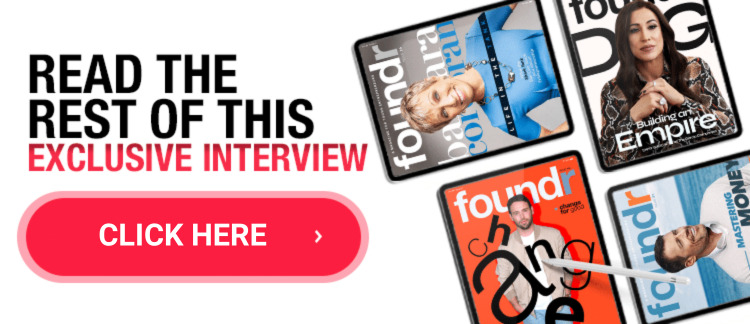
Meet the business behind the name.
You’ve probably read one of Simon Sinek’s LinkedIn posts or watched his countless talks online.
But who’s the real Simon Sinek?
In our modern world of personal brand empires, what’s the difference between a seven-figure machine and a single person with the same thoughts, feelings, pressures, and pains you have?
“I don’t really have a job, do I?” Sinek says.
He admits that his career was an accident. Sixteen years ago, the speaker, best-selling author, and founder of The Optimism Company stood on a stage in a Puget Sound conference room and set a trajectory for his life he never intended.
In 2010, Sinek gave a TED Talk that has since become one of the most-watched talks of all time on TED.com, with 60 million-plus views. His talk spurred NY Times best-selling books, speaking engagements, consulting gigs with globally-recognized brands, a podcast, a publishing arm, and viral quotes shared across social media.
And it all started with a question: Why?
Why Why?
Sinek grew up with his sister and parents trotting the globe, including Johannesburg, London, and Hong Kong. Because of the ever-changing nature of his childhood, his nuclear family, especially his sister, became his closest confidants.
“It taught me to be comfortable in the uncomfortable,” Sinek says about his international upbringing, which can be detected in his New Jersey accent with a dash of a UK twang. “It taught me that when I don’t know or don’t understand, to figure it out.”
But most importantly, his family taught him about relationships.
“It’s too difficult to do difficult things alone. We’re just not that good,” Sinek says. “And starting a business is exactly the same.”
The biggest lesson he’s learned as an entrepreneur is that he doesn’t have all the answers and doesn’t need to pretend to. Sinek learned that lesson when he seemingly had everything.
“I was living the entrepreneurial dream, we had amazing clients, and we did really good work,” Sinek says about his first business, a marketing consulting firm. “And yet, four years into that adventure, I fell out of love with it.”
Sinek was embarrassed to say that he didn’t want to do his work anymore because it all seemed so perfect externally.
“All my energy went into pretending that I was happier, more successful, and more in control than I actually felt, which is frankly a very dark place. It’s also a lonely place.”
Fortunately, one of Sinek’s friends saw through the facade and confronted him. Sinek came clean.
“It was like a huge weight off my shoulders that I could open up to somebody about what I was going through,” Sinek says. “It turns out I was surrounded by people that wanted to help me. They just didn’t think I needed it because I wasn’t admitting it.”
After his epiphany, he shifted the energy from pretending to finding a solution to how he felt.
The solution was his why.
“I knew what I did, I knew how I did it, but I realized I didn’t know why I was doing it, and that was the reason for my malaise,” Sinek says.
Sinek’s why is to inspire people to do the things that inspire them so that together, each of us can change our world for the better. He says that, like watching a good movie or reading a page-turning book, when he discovered his why, he had to tell people about it.
“It comes from that part of the brain that doesn’t control language, and so when it’s put into words, it’s awesomely powerful,” Sinek says.
Soon friends and friends of friends began searching for their whys and inviting Sinek to their living rooms to give raw versions of what would eventually become his TED Talk.
“I would help people find their why for a hundred dollars on the side,” Sinek says. “It was never supposed to be a career.”
Sinek’s “golden circle,” which he explains on a rudimentary paper easel with permanent markers in his TED Talk, is a visual of three enveloped circles representing why, how, and what. The principle of the theory is that most businesses work backward from the outside circle of what to the inner circle of why. Sinek argues that by starting with your why, individuals and organizations will know their purpose in business and, therefore, attract better talent, build better leaders, and do more innovative work.
His concept was radically simple yet universally applicable from startup founders to Fortune 500 CEOs. But it also lined up with Sinek’s purpose. So every invite he received following the TED Talk, which connected to his why, was a “yes.”
“It was the most inspiring thing I’ve ever done,” Sinek says.
Book deals and speaking engagements followed. He transformed his persona and ideas into a business—was it an entrepreneurial dream he’d have to fake?
No.
But it wasn’t enough—not infinitely enough.

The Infinite Ball Game
Sinek’s vision of why was inspired by Dr. James Carse’s 1986 book Finite and Infinite Games.
“It was the most powerful thing I’d ever found,” Sinek says.
He discovered Carse’s philosophy while searching for a solution but didn’t know how to implement it. Carse breaks business (and life) into two games—finite and infinite.
Finite games have known players, fixed rules, and an agreed-upon objective.
Infinite games have uncapped players, adaptable rules, and an objective not to win but to keep the game going.
For example, a Major League Baseball game has a set number of players, nine innings, and the goal to score more runs than the other team—it’s finite.
Compare that to the 1993 film The Sandlot, where a group of neighborhood friends partakes in a never-ending game of baseball in which the players come and go, the rules change constantly, and the goal is to play all summer long—infinite.
“No one will ever be declared the winner of a career. Certainly, there’s no such thing as winning business,” Sinek says. “Business is an infinite game.”
Sinek says that it’s reasonable to have clear goals and objectives for your business but not for the sake of sacrificing ethical practices and leadership traits.
“Where companies make mistakes is that they make visions about themselves,” Sinek says. “[Infinite thinking] is where organizations are significantly able to change the course of business or the world based on the things they invent, which is they weren’t trying to be billionaires; they were trying to invent something that they thought would significantly benefit the world—that’s what drove them.”
It was in his study of infinite thinking that Sinek discovered the simple practice of finding his why.
“Everybody said, ‘Simon, you have no focus,’ but they couldn’t see that I had more focus than everybody else, just my aperture was much wider,” Sinek says. “I’m interested in the kinds of businesses that have an impact and make people feel like work has a higher value than simply the money.”
The Thing
Each book, talk, and approach Sinek has developed in his career comes from personal experience.
“All of the work is semi-autobiographical,” Sinek says. “Every now and then, I find a solution to one of my challenges that turns out has value in other people’s lives as well.”
When Sinek started scaling his personal-branded business and leading a team, he began to have trust issues. It inspired him to seek out leaders in the military, where in his purview, people willingly gave up their lives for others they didn’t know.
“In business, we don’t even like to give up credit for things,” Sinek says.
“I think this is the mistake we make as entrepreneurs, which is we think it’s about us. In reality, it’s the people around us.”
His learnings from military leaders inspired his book Leaders Eat Last. Of all the successful leaders he’s worked with over his career, their universal trait is courage.
He explains that after talking with former Navy SEALs, he noticed that even when they are physically and emotionally exhausted, they somehow find the courage and energy to help the person next to them.
“It’s service. Service is the thing,” Sinek says. “It’s that relationship that gives us the most remarkable courage.”
When Sinek works with startups and entrepreneurs, he repeatedly gets asked what it takes to overcome obstacles. He says there are scenarios when businesses wait too long to quit or quit too soon, but nobody has the correct answer.
“When you’re a startup, you have to have the ability to have people do something that is—let’s be honest—stupid,” Sinek says. “If you can articulate something that’s so compelling that your friends are willing to quit their jobs to come to support you to do that—you’re onto something.”
In the Business of Optimism
Sinek’s been onto something for almost two decades. His business, The Optimism Company, encompasses keynotes, workshops, books, courses, and a publishing company.
Why optimism?
He says, “Why not?”
“We live in a cynical world, and I think the one thing we could all use is a little more optimism,” Sinek says.
Optimism isn’t blind positivity, according to Sinek. He says optimism is the undying belief that the future is bright. You need people, including skeptics, to work together to pursue an “unrealizable destination.”
That’s why Sinek is so bullish about business leaders leading with courage.
“Simple promises of equity are tricking people, not inspiring people,” Sinek says. “Fostering deep, meaningful relationships is probably the single most important thing you can do if you want to be a successful entrepreneur.”
“Fostering deep, meaningful relationships is probably the single most important thing you can do if you want to be a successful entrepreneur.”
Sinek jokes that there’s an entire section in bookstores called “self-help,” and there’s no section called “help others.” He says he wants to pioneer the “help others” industry through The Optimism Company.
So who is the real Simon Sinek?
“I’m still the same idiot now as I was then,” he says.
Throughout his career, he’s learned to be confident in his shortcomings, surround himself with people smarter than him, and continue asking for help from those who love him.
“If you don’t have that love, you’re not going to solve the problems,” Sinek says. “None of us is strong enough, smart enough, or good enough to do anything difficult by ourselves.”
Simon Sinek didn’t get into the business of being Simon Sinek. He got into the business of why Simon Sinek.
So why did you start your business?
Simon Sinek’s Friend Exercise
A simple way to find your why is to call a friend. Here’s how:
Step 1: Find a friend who knows you and loves you (no spouse, no family).
Step 2: Ask, “Why are we friends?”
Step 3: They’ll probably respond with a generic answer.
Step 4: Convert the question to “What specifically is it about me that you know I’ll be there for you no matter what?”
Step 5: If you receive another vague response, play devil’s advocate and ask again, “What’s specifically?”
Step 6: Eventually, they’ll share an honest feeling that will give you an immediate emotional response.
That response proves that the value you fill in their life is YOUR why that you can give to the world.








